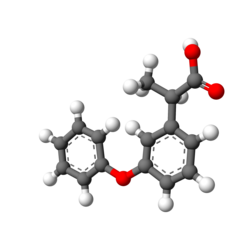 | |
 | |
| Clinical data | |
|---|---|
| Trade names | Nalfon |
| AHFS/Drugs.com | Monograph |
| MedlinePlus | a681026 |
| Pregnancy category |
|
| Routes of administration | By mouth |
| ATC code | |
| Legal status | |
| Legal status | |
| Pharmacokinetic data | |
| Metabolism | Major urinary metabolites are fenoprofen glucuronide and 4′-hydroxyfenoprofen glucuronide. |
| Elimination half-life | 3 hours |
| Excretion | Renal (~90%) |
| Identifiers | |
| |
| CAS Number | |
| PubChem CID | |
| IUPHAR/BPS | |
| DrugBank | |
| ChemSpider | |
| UNII | |
| KEGG | |
| ChEBI | |
| ChEMBL | |
| CompTox Dashboard (EPA) | |
| ECHA InfoCard | 100.046.213 100.045.231, 100.046.213 |
| Chemical and physical data | |
| Formula | C15H14O3 |
| Molar mass | 242.274 g·mol−1 |
| 3D model (JSmol) | |
| |
| |
| (verify) | |
Fenoprofen, sold under the brand name Nalfon among others, is a nonsteroidal anti-inflammatory drug (NSAID). Fenoprofen calcium is used for symptomatic relief for rheumatoid arthritis, osteoarthritis, and mild to moderate pain. It has also been used to treat postoperative pain. [1] It is available as a generic medication. [2] [3]